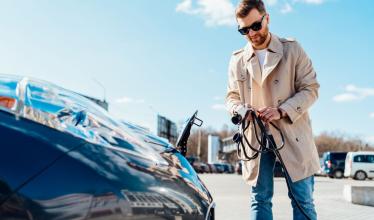Volkswagen has launched two innovative electric car charging projects to explore the potential of future automated parking and EV charging.
In the EU research project called ‘V-Charge’, short for Valet Charge, Volkswagen have demonstrated a part-autonomous electric Golf which is able, without a driver, to search and find an empty parking space.
On parking the e-Golf then locates an inductive charging unit (positioned beneath the car) and initiates charging. Once charging is completed, the vehicle automatically vacates the charging bay for another electric vehicle and parks itself in a conventional parking space.
For navigation, the vehicle uses a digital map sourced from the parking area or car park supplemented by information from on-board cameras and ultrasound sensors. This allows the car to drive in so-called ‘mixed traffic’ and avoid other vehicles and pedestrians when necessary.
V-Charge is a international multi-partner project including Volkswagen, Bosch and the project lead, the Swiss Federal Institute of Technology (ETH) in Zurich, responsible for visual systems and control. Bosch contributes its sensor technology expertise while Oxford University is also involved providing details mapping of the test car park areas.
Taking a different approach, VW is also exploring the us of robots to improve access and usage of more conventional conduction charging units. In the ‘e-smartConnect’ project, the car maker has developed an automated rapid charging system for the next generation of EVs.
On parking alongside a specially designed rapid charger, a robot arm, more often associated with car production plants than vehicle charging bays, is programmed to conduct all the movements required to successfully select a tethered rapid connector and connect it with the inlet port on-borad the vehicle.
Accoring to Volkswagen: “[As] the next generation of electric vehicles will be equipped with higher-capacity batteries… high charging capability (from 80 to 150 kW or more) is needed if such energy storage devices are to be charged quickly. This can be achieved with rapid DC charging technology, but this approach also requires the use of thick cables.
“The weight and stiffness of such cables makes them difficult to handle. The research goal of the e-smartConnect project is therefore to automatically couple a DC connector to the vehicle.”
The robot employed by the e-smartConnect project is a ‘LBR iiwa’ lightweight device supplied by Kuka. The robot’s seven drive axles and integrated torque sensors ensure a precise, force sensing, and reliable connection.
Volkswagen, V-Charge



